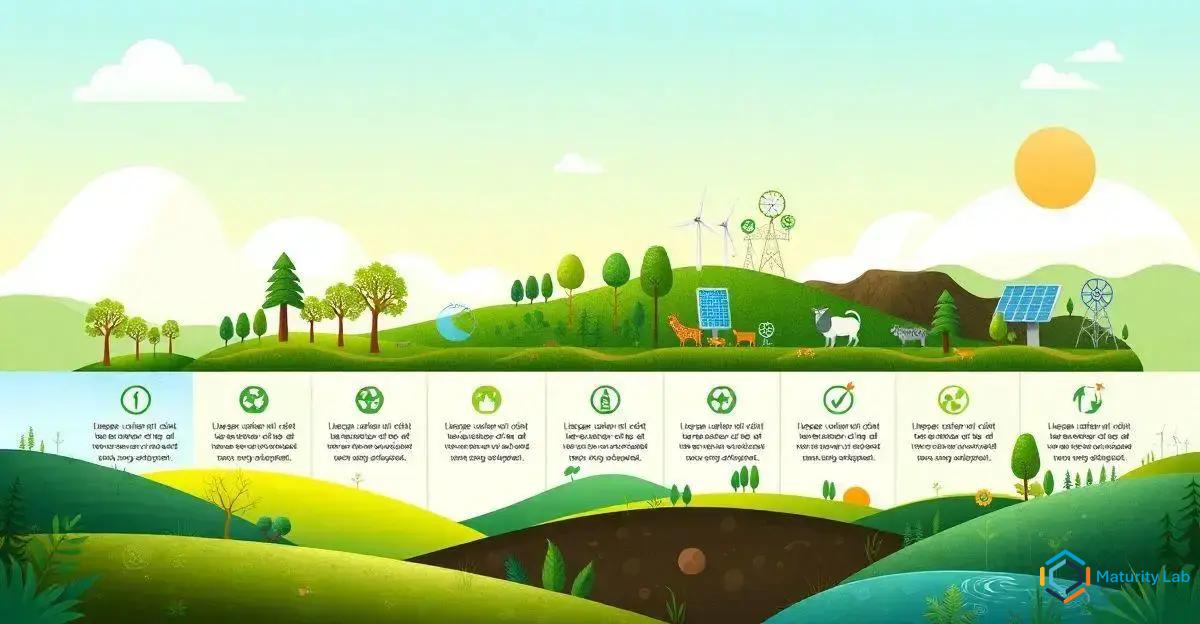The Sustainability Maturity Model is a strategic framework that helps organizations improve their environmental sustainability practices by assessing current maturity levels and developing structured plans. It focuses on key areas such as resource efficiency, waste management, biodiversity conservation, climate change mitigation, and stakeholder engagement, promoting strategies like energy efficiency, sustainable supply chains, and water conservation for continuous improvement and innovation, ultimately leading to sustainable growth and operational efficiencies.
In today’s business landscape, understanding the Sustainability Maturity Model is crucial for organizations aiming to enhance their environmental sustainability and achieve significant impact reduction. This model serves as a comprehensive framework, guiding companies through the stages of maturity necessary to implement sustainable practices effectively. By leveraging this model, businesses can identify their current level of sustainability maturity and develop strategic plans to advance towards greater environmental responsibility. The journey towards sustainability is not only beneficial for the planet but also enhances corporate reputation and operational efficiency.
Understanding the Sustainability Maturity Model

The Sustainability Maturity Model serves as a vital framework for organizations striving to integrate sustainable practices into their operations. This model delineates various stages of maturity, each representing a different level of commitment and capability in environmental sustainability. At its core, the model provides a structured approach to assess and enhance an organization’s sustainability efforts, ensuring that they align with both strategic objectives and environmental responsibilities.
At the initial stage, organizations typically exhibit a basic awareness of sustainability issues, often driven by regulatory compliance or external pressures. Here, sustainability initiatives are sporadic and lack integration into the broader business strategy. As organizations progress to higher maturity levels, they begin to embed sustainability into their core operations, fostering a culture that prioritizes environmental stewardship. This transition is marked by the development of clear sustainability goals, the allocation of resources, and the establishment of metrics to measure progress.
A critical aspect of the Sustainability Maturity Model is its emphasis on continuous improvement. Organizations are encouraged to regularly evaluate their sustainability practices, identify areas for enhancement, and implement innovative solutions to reduce their environmental impact. This iterative process not only advances an organization’s sustainability maturity but also drives operational efficiencies and cost savings.
Moreover, the model underscores the importance of stakeholder engagement. As organizations advance in maturity, they increasingly involve stakeholders, including employees, customers, and suppliers, in their sustainability initiatives. This collaborative approach not only enhances the effectiveness of sustainability efforts but also strengthens relationships and builds trust.
In summary, the Sustainability Maturity Model provides a comprehensive roadmap for organizations seeking to elevate their sustainability practices. By understanding and applying this model, businesses can systematically enhance their environmental performance, ultimately contributing to a more sustainable future. Wouldn’t it be prudent for your organization to assess its current sustainability maturity and embark on a journey towards greater environmental responsibility?
Key Components of Environmental Sustainability

Key Components of Environmental Sustainability
Environmental sustainability is a multifaceted concept that encompasses various components, each playing a crucial role in ensuring the long-term health and viability of our planet. Understanding these components is essential for organizations aiming to implement effective sustainability strategies and achieve meaningful impact reduction.
One of the primary components of environmental sustainability is resource efficiency. This involves optimizing the use of natural resources such as water, energy, and raw materials to minimize waste and reduce environmental impact. By adopting resource-efficient practices, organizations can lower operational costs and decrease their ecological footprint, contributing to a more sustainable future.
Waste Management
Another critical component is waste management. Effective waste management strategies focus on reducing, reusing, and recycling materials to minimize the amount of waste sent to landfills. Organizations can implement comprehensive waste management programs that include waste audits, employee training, and the adoption of circular economy principles to enhance sustainability outcomes.
Biodiversity conservation is also a key aspect of environmental sustainability. Protecting and preserving diverse ecosystems is vital for maintaining ecological balance and supporting the myriad of life forms that inhabit our planet. Organizations can contribute to biodiversity conservation by implementing practices that reduce habitat destruction, pollution, and resource depletion.
Climate change mitigation is an integral component of environmental sustainability. This involves reducing greenhouse gas emissions through the adoption of renewable energy sources, energy-efficient technologies, and sustainable transportation options. By actively working to mitigate climate change, organizations can play a significant role in protecting the planet for future generations.
Lastly, stakeholder engagement is essential for achieving environmental sustainability. Engaging with stakeholders, including employees, customers, suppliers, and the community, fosters collaboration and ensures that sustainability initiatives are aligned with the needs and expectations of all parties involved. This collaborative approach enhances the effectiveness of sustainability efforts and builds a strong foundation for long-term success.
In conclusion, understanding the key components of environmental sustainability enables organizations to develop comprehensive strategies that address various environmental challenges. By focusing on resource efficiency, waste management, biodiversity conservation, climate change mitigation, and stakeholder engagement, businesses can drive meaningful change and contribute to a more sustainable world. How can your organization integrate these components into its sustainability strategy to achieve greater environmental impact?
Strategies for Effective Impact Reduction

Implementing effective strategies for impact reduction is paramount for organizations committed to enhancing their environmental sustainability. These strategies not only help in minimizing the ecological footprint but also contribute to long-term operational efficiencies and cost savings.
One of the most effective strategies is the adoption of energy-efficient technologies. By investing in advanced technologies such as LED lighting, energy-efficient HVAC systems, and smart building management systems, organizations can significantly reduce their energy consumption. This not only lowers greenhouse gas emissions but also results in substantial cost savings over time.
Additional Strategies
Another critical strategy is the implementation of sustainable supply chain practices. Organizations can work closely with suppliers to ensure that raw materials are sourced sustainably and that production processes adhere to environmental standards. This includes conducting supplier audits, setting sustainability criteria for procurement, and fostering long-term partnerships with eco-friendly suppliers.
Water conservation is also a vital strategy for impact reduction. Implementing water-saving technologies, such as low-flow fixtures and water recycling systems, can help organizations reduce their water usage and minimize their impact on local water resources. Additionally, conducting regular water audits can identify areas for improvement and ensure efficient water management.
Waste reduction initiatives are essential for minimizing environmental impact. Organizations can implement comprehensive waste management programs that focus on reducing, reusing, and recycling materials. This includes conducting waste audits, promoting employee awareness and training, and adopting circular economy principles to minimize waste generation.
Engaging employees in sustainability initiatives is another effective strategy. By fostering a culture of sustainability within the organization, employees are more likely to adopt eco-friendly practices in their daily work. This can be achieved through sustainability training programs, employee recognition for sustainable practices, and encouraging participation in environmental initiatives.
In summary, effective impact reduction requires a multifaceted approach that encompasses energy efficiency, sustainable supply chain practices, water conservation, waste reduction, and employee engagement. By implementing these strategies, organizations can significantly reduce their environmental impact and contribute to a more sustainable future. How can your organization leverage these strategies to enhance its sustainability efforts and achieve meaningful impact reduction?
Implementing Maturity Models for Sustainable Growth

Implementing Maturity Models for Sustainable Growth
The implementation of maturity models is a strategic approach that organizations can leverage to achieve sustainable growth. These models provide a structured framework that guides businesses through various stages of development, enabling them to enhance their sustainability practices systematically.
The first step in implementing a maturity model is conducting a comprehensive assessment of the organization’s current sustainability practices. This involves evaluating existing processes, identifying strengths and weaknesses, and determining the current level of maturity. By understanding where they stand, organizations can set realistic goals and develop a roadmap for progression.
Once the assessment is complete, organizations can begin to align their sustainability objectives with the maturity model’s framework. This alignment ensures that sustainability initiatives are integrated into the overall business strategy, promoting a cohesive approach to growth. Key performance indicators (KPIs) should be established to measure progress and ensure accountability.
A critical aspect of implementing maturity models is fostering a culture of continuous improvement.
Organizations should encourage innovation and experimentation, allowing teams to explore new sustainability practices and technologies. This culture not only drives progress but also empowers employees to take ownership of sustainability initiatives.
Collaboration is also essential for successful implementation. Engaging stakeholders, including employees, customers, suppliers, and the community, ensures that sustainability efforts are aligned with broader expectations and needs. Collaborative efforts can lead to innovative solutions and enhance the overall effectiveness of sustainability initiatives.
Furthermore, organizations should invest in training and development to build the necessary skills and knowledge required for advancing through the maturity model. Providing employees with the tools and resources they need to succeed fosters a more sustainable and resilient organization.
In conclusion, implementing maturity models for sustainable growth involves a strategic approach that includes assessment, alignment, continuous improvement, collaboration, and investment in training. By following this structured framework, organizations can systematically enhance their sustainability practices and achieve long-term growth. How can your organization utilize maturity models to drive sustainable growth and enhance its environmental performance?
In the pursuit of environmental sustainability, the adoption of maturity models offers organizations a comprehensive framework to guide their journey towards sustainable growth.
By understanding the Sustainability Maturity Model, businesses can assess their current practices and strategically plan for advancement.
The key components of environmental sustainability, including resource efficiency, waste management, biodiversity conservation, climate change mitigation, and stakeholder engagement, provide a foundation for developing robust sustainability strategies.
Effective Impact Reduction Strategies
Effective impact reduction strategies, such as energy efficiency, sustainable supply chain practices, water conservation, waste reduction, and employee engagement, are essential for minimizing ecological footprints and enhancing operational efficiencies.
Implementing maturity models facilitates a structured approach to integrating these strategies into the core business operations, fostering a culture of continuous improvement and innovation.
Ultimately, the successful implementation of maturity models for sustainable growth requires collaboration, alignment with strategic objectives, and investment in training and development.
By embracing these principles, organizations can not only enhance their environmental performance but also achieve long-term operational and financial benefits.
As businesses navigate the complexities of sustainability, the maturity model serves as a valuable tool, guiding them towards a more sustainable and resilient future.
How will your organization leverage these insights to drive its sustainability journey forward?
Frequently Asked Questions about Sustainability Maturity Model
What is the Sustainability Maturity Model?
The Sustainability Maturity Model is a framework that helps organizations assess and enhance their sustainability practices by guiding them through various stages of maturity, from basic awareness to integrated sustainability strategies.
Why is resource efficiency important in environmental sustainability?
Resource efficiency is crucial because it optimizes the use of natural resources, reduces waste, lowers operational costs, and minimizes the environmental impact, contributing to a more sustainable future.
How can organizations effectively reduce their environmental impact?
Organizations can reduce their environmental impact by adopting energy-efficient technologies, implementing sustainable supply chain practices, conserving water, reducing waste, and engaging employees in sustainability initiatives.
What role does stakeholder engagement play in sustainability?
Stakeholder engagement is vital as it fosters collaboration, ensures that sustainability efforts align with broader expectations, and enhances the effectiveness of sustainability initiatives by involving employees, customers, suppliers, and the community.
How do maturity models support sustainable growth?
Maturity models support sustainable growth by providing a structured framework for assessing current practices, setting goals, fostering continuous improvement, and integrating sustainability into core business operations.
What are the benefits of implementing maturity models for sustainability?
Implementing maturity models for sustainability offers benefits such as enhanced environmental performance, operational efficiencies, cost savings, innovation, and alignment with strategic business objectives, leading to long-term growth and resilience.

